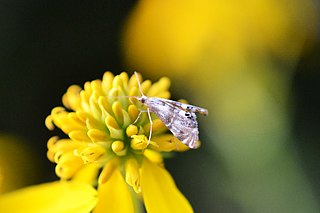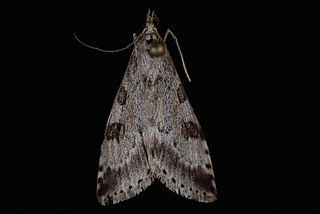Related Research Articles

Petrophila is a genus of moths of the family Crambidae. The genus was described by Lansdown Guilding in 1830.
Cacozelia basiochrealis, the yellow-based cacozelia, is a species of snout moth in the genus Cacozelia. It was described by Augustus Radcliffe Grote in 1878. It is found in the southern part of the United States.
Thaumatopsis edonis is a moth in the family Crambidae. It was described by Augustus Radcliffe Grote in 1880. It is found in North America, where it has been recorded from Florida, Kentucky, Maine, Massachusetts, Mississippi, Missouri, Nebraska, New Jersey, Oklahoma and South Carolina. It is listed as threatened in the US state of Connecticut.
Evergestis funalis is a moth in the family Crambidae. It was described by Augustus Radcliffe Grote in 1878. It is found in North America, where it has been recorded from Alaska, Arizona, British Columbia, California, Colorado, Nevada, Oregon, Utah and Washington.
Evergestis simulatilis is a moth in the family Crambidae. It was described by Augustus Radcliffe Grote in 1880. It is found in North America, where it has been recorded from Alberta, Arizona, British Columbia, California, Colorado, Montana, Nevada and New Mexico.
Prorasea simalis is a moth in the family Crambidae. It was described by Augustus Radcliffe Grote in 1878. It is found in North America, where it has been recorded from Alberta, California, Colorado, Nevada and Oregon.
Stegea eripalis is a moth in the family Crambidae. It was described by Augustus Radcliffe Grote in 1878. It is found in North America, where it has been recorded from Alabama, Arkansas, Florida, Illinois, Indiana, Maryland, Mississippi, Ohio, Oklahoma, Ontario, South Carolina, Tennessee and Texas.
Loxostege albiceralis is a moth in the family Crambidae. It was described by Augustus Radcliffe Grote in 1878. It is found in North America where it has been recorded from southern California and Nevada to Texas. The habitat consists of arid areas and deserts.
Loxostege anartalis is a moth in the family Crambidae. It was described by Augustus Radcliffe Grote in 1878. It is found in North America, where it has been recorded from coast to coast in Canada. In the west, the range extends south to California.
Pyrausta atropurpuralis is a moth in the family Crambidae. It was described by Augustus Radcliffe Grote in 1877. It is found in North America, where it has been recorded from Texas, New Mexico and Colorado.
Pyrausta nicalis is a moth in the family Crambidae. It was described by Augustus Radcliffe Grote in 1878. It is found in North America, where it has been recorded from Quebec west to British Columbia, south to Colorado, Utah, Nevada and California.
Pyrausta tatalis is a moth in the family Crambidae. It was described by Augustus Radcliffe Grote in 1877. It is found in North America, where it has been recorded from California to Texas and Oklahoma.
Xanthostege plana is a moth in the family Crambidae. It was described by Augustus Radcliffe Grote in 1883. It is found in North America, where it has been recorded from Arizona and Texas.
Colomychus talis, the distinguished colymychus moth, is a moth in the family Crambidae. It was described by Augustus Radcliffe Grote in 1878. It is found in Mexico and the south-eastern United States, where it has been recorded from Alabama, Arkansas, Florida, Georgia, Maryland, North Carolina, Oklahoma, South Carolina and Virginia.

Diacme adipaloides, the darker diacme moth, is a moth in the family Crambidae. It was described by Augustus Radcliffe Grote and Coleman Townsend Robinson in 1867. It is found in North America, where it has been recorded from Alabama, Arkansas, Florida, Indiana, Maine, Maryland, Massachusetts, Michigan, Minnesota, New Brunswick, New Hampshire, New Jersey, New York, North Carolina, Nova Scotia, Ohio, Oklahoma, Ontario, Quebec, South Carolina, Tennessee, Texas, Virginia, West Virginia and Wisconsin.
Loxomorpha flavidissimalis is a moth in the family Crambidae. It was described by Augustus Radcliffe Grote in 1877. It is found in the United States, where it has been recorded from Texas, Florida, North Carolina and West Virginia. It is also found in Mexico and Puerto Rico. It has also been recorded from Australia.
Mecyna fuscimaculalis is a moth in the family Crambidae. It was described by Augustus Radcliffe Grote in 1878. It is found in North America, where it has been recorded from Texas and Alberta.
Mecyna submedialis, the orange-toned mecyna moth, is a moth in the family Crambidae. It was described by Augustus Radcliffe Grote in 1876. It is found in North America, where it has been recorded from Ontario and Michigan, south to Florida and west to Arkansas. It has also been recorded from Alberta.
Mimorista trimaculalis is a moth in the family Crambidae. It was described by Augustus Radcliffe Grote in 1878. It is found in North America, where it has been recorded from Arizona, California, Nevada, New Mexico, Texas and Utah.

Udea washingtonalis, the Washington udea moth, is a moth in the family Crambidae. It was described by Augustus Radcliffe Grote in 1882. It is found in North America, where it has been recorded from Alaska, British Columbia, California, Montana and Washington.
References
- ↑ Nuss, M.; et al. (2003–2014). "GlobIZ search". Global Information System on Pyraloidea. Retrieved July 15, 2014.
- ↑ "800761.00 – 4781 – Petrophila avernalis – (Grote, 1878)". North American Moth Photographers Group. Mississippi State University. Retrieved August 9, 2018.
- ↑ Heiman, Maury J. (October 23, 2013). "Species Petrophila avernalis - Hodges#4781". BugGuide. Retrieved August 9, 2018.
| This Petrophila-related article is a stub. You can help Wikipedia by expanding it. |